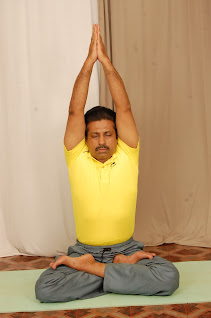Pranayama
Pranayama is the fourth of eight limbs of Ashtanga Yoga. Sage Patanjali in his work Yoga Sutras writes about pranayama as the means through which higher level of consciousness can be achieved. Prana means "breath", "energy" or "vitality" and ayama means "stretch", "restraint", "expansion" or "control". Pranayama refers to the practice of controlling breath or energy thereby regulating flow of prana to obtain optimum health benefits, both physical and psychological. Pranayama not only regulates prana but also regulates the thought processes and actions of the practitioner aiding in attaining peace within.
There are four stages of pranayama namely arambha, ghata, parichaya and nispatti. Aramba, meaning commencement, is the stage in which the practitioner's interest in breathing techniques is kindled. Nispatti, the final stage, is when the practitioner experiences eternal bliss.
Inhalation while performing pranayama is called puraka, retention of breath inside is kumbhaka and exhalation is rechaka.
Types of Pranayama
Out of the various types of pranayama, here are the important types:
- Kapalabhati
- Bhastrika pranayama
- Anulom Vilom
- Nadi sodhana pranayama
- Sitali pranayama
- Sitakari pranayama
- Ujjayi pranayama
- Agnisar kriya
- Suryan bhedan pranayama
- Brahmari pranayama
Benefits of Pranayama
The benefits of practising pranayama include:
- Promotes respiratory function
- Improves digestion
- Reduces excess fat
- Improves blood circulation
- Lowers blood pressure
- Supports heart health
- Stimulates nervous system
- Boosts immunity
- Aids in detoxification
- Alleviates stress thereby curing and preventing stress related disorders
- Promotes calm and serenity


Comments
Post a Comment